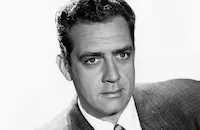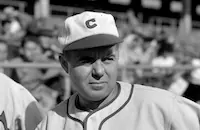The Blue Gardenia

Brief Synopsis
Cast & Crew
Fritz Lang
Anne Baxter
Richard Conte
Ann Sothern
Raymond Burr
Jeff Donnell
Film Details
Technical Specs

Synopsis
In Los Angeles, while writing a feature story about telephone operators, columnist Casey Mayo sees calendar girl artist Harry Prebble sketching the operators. In vain, Prebble tries to make a date with one of the women, divorcée Crystal Carpenter, but she leaves with her two roommates and fellow operators, Norah Larkin and Sally Ellis. Prebble then cuts short a phone call from Rose, a woman he has been dating, who is almost hysterical in her need to talk to him. That night, Norah spends her birthday alone and reads a letter from her fiancé, a soldier fighting in Korea. After she reads that he is breaking their engagement, the telephone rings, and still in shock, she answers and agrees to have dinner at the Blue Gardenia Restaurant with Prebble, who thinks he is talking to Crystal. At the restaurant, as Norah drinks too much, Prebble buys her a gardenia corsage from a blind flower vendor and the restaurant entertainer sings "Blue Gardenia." Later, after taking the drunken Norah to his apartment and putting on a recording of "Blue Gardenia," Prebble tries to force himself on her. As Norah struggles, she hits him with a fireplace poker and breaks a mirror, but then faints. She runs out in haste after she awakens, leaving her shoes behind. Norah suffers a hangover the next day and can recall little of the previous evening, but after reading about Prebble's murder in the newspaper, she fears that she killed him. Police captain Sam Haynes's investigation has been stymied by Prebble's housekeeper, who has wiped off fingerprints and tidied Prebble's apartment. Haynes's only clues to the murder are a pair of women's shoes, a gardenia corsage, a lacy handkerchief and the record on the phonograph turntable, which was still spinning when the housekeeper arrived. While the police proceed with a manhunt, Casey takes an interest and shows up at Prebble's apartment, where Haynes plays the record for him. After tracing the corsage to the restaurant, Casey nicknames the killer, "The Blue Gardenia," and writes her an open letter, promising the newspaper's help in hiring the best legal defense, if she will come to him with her story. Casey is harangued by crank calls and dismisses a call from Rose, because she does not identify the shoes found by the police. Meanwhile, Norah's tension is noticed by Crystal and Sally, who assume she is grieving for her ex-boyfriend. Tormented by memory flashes, Norah tries to piece together events of the terrifying night. During his own investigation, Casey learns from the Blue Gardenia staff that Prebble was with a blonde in black satin on the night of his death. Reading the description in Casey's column, Norah burns her dress, but then, late one night, decides to contact Casey from a pay phone. After claiming to be calling for a friend, she agrees to meet him at an all-night diner, where she explains that her "friend" can only remember swinging the poker in self-defense while "Blue Gardenia" played on the phonograph. Casey finds himself attracted to Norah, but hides his feelings and urges her to have the friend meet him the next day at the diner. When Norah returns home, Crystal is waiting, having connected Norah to the now famous murder case, and the next day, accompanies her to the diner. After surprising Casey with the revelation that she is the "Blue Gardenia," Norah realizes that Casey's offer to help was a trick to get a story. Norah leaves, but is arrested by Haynes and his men, who were tipped off by the diner staff. As Norah, who now believes that Casey set a trap, is booked, Casey proceeds to the airport with his photographer, Al, for an overseas assignment. Waiting for the plane, Casey recognizes music being piped into the lounge as that found on Prebble's phonograph, then remembers Norah saying that Prebble played a different song, "Blue Gardenia," when she was there. He contacts Haynes and together they go to the record shop where Prebble bought the record found by the police. Rose, who works there, thinks they have come for her and attempts suicide. Later, at the hospital, Rose confesses that she showed up at Prebble's to talk that night and seeing Norah's corsage and handkerchief, realized he was seeing someone else. Rose explains that Prebble tried to calm her by playing the song that he bought at the record store when they first met, but she killed him in a jealous rage. Norah is released, but remains distant from Casey, who wants to make amends. However, Crystal advises him not to give up, and he feels sure that he and Norah have a future together.

Director

Fritz Lang
Cast

Anne Baxter

Richard Conte

Ann Sothern

Raymond Burr

Jeff Donnell
Richard Erdman

George Reeves
Ruth Storey

Ray Walker

Nat "king" Cole
Celia Lovsky
Crew
James Barker
Izzy Berne
Vera Caspary
Willis Cook
Maria Donovan
Emmett Emerson
Alex Gottlieb
Daniel Hall
Gene Hibbs
Charles Hoffman
Raoul Kraushaar
Lester Lee
Edward Mann
Don Mcdougall
Nicholas Musuraca
Nelson Riddle
Bob Russell
Maurie Suess
Ben Winkler

Photo Collections
Videos
Movie Clip




Hosted Intro



Film Details
Technical Specs

Articles
The Blue Gardenia
Neither Lang nor many of his champions would go on to accord such status to The Blue Gardenia (1953), a thriller that the director took on contract for Warner Brothers and crafted within a tidy twenty days. Regardless, the atmospheric touches, jarring visuals and sense of paranoia with which Lang imbued this studio quickie prevent it from warranting such simple dismissal.
Adapted from a short story by Laura author Vera Caspary, the narrative introduces all the principals involved in a scattershot fashion before reaching the dramatic thrust. Norah Larkin (Anne Baxter), a Los Angeles switchboard operator sharing an apartment with two co-workers, is devastated when an anticipated letter from her fiance in Korea turns out to be of the "Dear Jane" variety. Intercepting a phone call meant for her roommate (Ann Sothern), she eventually gives a why-not response to the caller's entreaties for a date.
Arriving at the trendy nightspot of the film's title, she makes her rendezvous with Harry Prebble (Raymond Burr), a slick-talking commercial draftsman with a predilection for calendar girls that isn't merely vocational. After multiple rounds of cocktails, the now-impaired Norah agrees to make a stop back at Prebble's studio. Once Harry attempts to force himself on her, however, she struggles, shattering a mirror as she passes out. Norah recovers enough consciousness to stagger her way home and collapse.
The dawn, however, brings far worse consequences than a mere hangover, as the tabloids and airwaves bear reports of Prebble's death at the hands of an unknown assailant. Casey Mayo (Richard Conte), a high-powered newspaper columnist and acquaintance of Prebble's, dubs the mystery woman with whom Prebble was last seen alive "the Blue Gardenia," and begins a public drumbeat for her to turn herself in. Wracked with guilt, and causing concern to her friends with her increasingly paranoid behavior, Norah has a torturous struggle over whether to put herself in Mayo's hands.
Lang may have regarded The Blue Gardenia as no more than a rushed job for hire, but the circumstances didn't quell his hunger for innovation. Working in conjunction with Nicholas Musuraca, the cinematographer who shot Lang's Clash by Night (1952) and many other memorable noir efforts for RKO, the filmmakers devised a revolutionary dolly that allowed for sustained tracking shots, and which provides the film's narrative with an intimacy comparable to handheld photography. "The practice of cutting in close-ups not only seems unnatural, but oftentimes interrupts and disturbs the filmic train of thought," the director once told interviewer Friedrich Porges. "The photographic apparatus becomes the constant companion of the actors; it becomes a sharp observer of the events, capturing the drama more intensively as it draws quickly nearer when something decisive is done or said."
Musuraca's lighting choices for The Blue Gardenia may have, on balance, owed more to then-prevalent television standards than his prior work, but the film still boasts many expressionistic visuals. From the vortex that envelopes Norah at the point of her collapse to the rain-streaked window looking in at the peak of her vulnerability, The Blue Gardenia creates a sustained sensation of impending doom and offers much of what lent Lang his enduring distinction in the field.
The Blue Gardenia also benefits from the game efforts of its players. Baxter hits the right notes as the conscience-plagued heroine; Burr is wonderfully smarmy as her would-be seducer; and Sothern engagingly delivers in a familiar assignment as the wisecracking confidante. Worked into the plotline with surprising frequency is Nat "King" Cole's smoky rendition of the title tune.
Producer: Alex Gottlieb
Director: Fritz Lang
Screenplay: Charles Hoffman, based on the story by Vera Caspary
Art Direction: Daniel Hall
Cinematography: Nicholas Musuraca
Editing: Edward Mann
Music: Raoul Kraushaar
Cast: Anne Baxter (Norah Larkin), Richard Conte (Casey Mayo), Ann Sothern (Crystal Carpenter), Raymond Burr (Harry Prebble), Jeff Donnell (Sally Ellis), Nat "King" Cole (Himself), Richard Erdman (Al).
BW-89m.
by Jay Steinberg

The Blue Gardenia
Quotes
Trivia
Notes
According to a September 1952 Hollywood Reporter news item, Alex Gottlieb, who produced The Blue Gardenia, bought the property from producer Howard Welsch and planned to release it independently. Although their appearances in the completed picture have not been confirmed, December 1952 Hollywood Reporter news items add Victor Sen Yung, Charles Victor and Ron Kennedy to the cast, and a December 1952 Hollywood Reporter news item adds Bo Ling, Esther Lee and Shirley Lew as telephone operators. According to a December 1952 Hollywood Reporter news item, actress Anne Baxter, who played "Norah Larkin," suffered a torn ligament while filming the fight scene with Raymond Burr. Ruth Storey, who played "Rose," was the real-life wife of Richard Conte.
The Blue Gardenia marked Sothern's return to films after a two-year absence. The Los Angeles Daily News review noted that the film's title was reminiscent of a 1947 Los Angeles murder case, in which the victim was dubbed "The Black Dahlia" by the press. However, the still officially unsolved case and the film's plot bear little similarity to each other. A Lux Radio Theatre adaptation of the film was aired on November 30, 1954, starred Dana Andrews and Ruth Roman.

Miscellaneous Notes
Released in United States on Video February 9, 1999
Released in United States Spring March 28, 1953
Completed shooting December 24, 1952.
Released in United States on Video February 9, 1999
Released in United States Spring March 28, 1953













